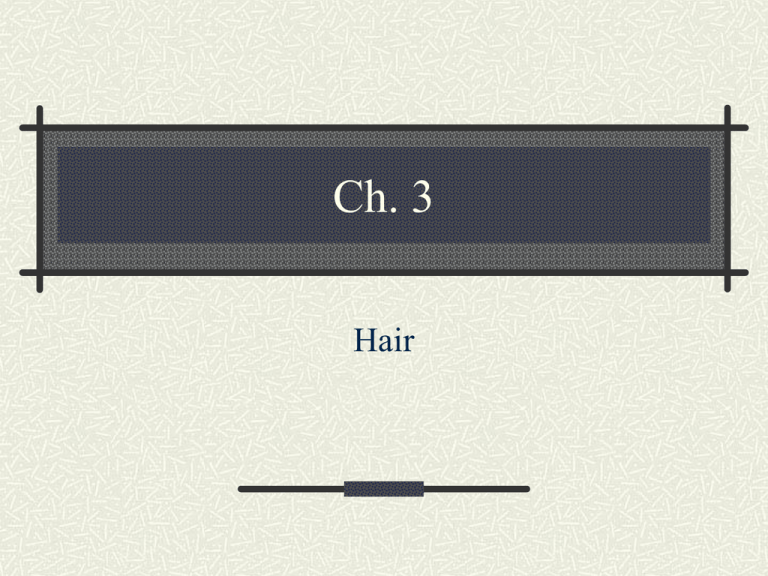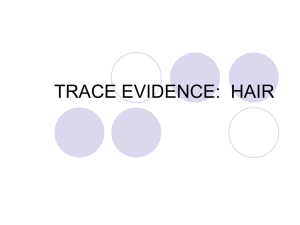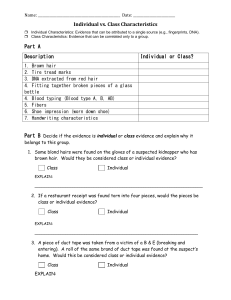Hair
advertisement

Ch. 3 Hair Napoleon Hair (watch beginning) Neutron activation analysis (old)- 18 min Napoleon Poisoning Claims Debunked Forensic Analysis of Hair Trace evidence- hair and fiber Hair Evidence Class evidence 1st job: determine if animal or human Composed of protein (keratin), an appendage of the skin that grows out of hair follicle Each species possesses hair w/ characteristics length, color, shape, root appearance & internal features Types of hair recovered & condition & number of hairs collected all impact their value as evidence Morphology Study of the structure or form of hair Function of Hair Regulate body temp Decrease friction Protect against sunlight Sense organ Camoflauge The Structure of Hair The Structure of Hair The Structure of Hair Phases (development stages) Anagen Cyclical growth Initial growth period where follicle is actively producing hair (materials are deposited in cells) May last 3-6 years, 80-90 % of hair is this phase Follicular tag- root is attached to follicle for growth, when hair is yanked out root is still attached- can use tag for DNA Catagen Transition period Occurs between anagen & telogen phases 2% in this phase Roots are elongated Telogen Resting phase 10-18% of hair Most commonly found piece of evidence Last about 100 days, easily dislodged Root is club shaped Final growth phase in which hair sheds Parts of Hair Hair is an appendage of the skin that grows out of an organ known as the hair follicle Hair follicle: origin of growth of the root, shaft and tip club shaped structure in skin w/ network of blood vessels called papilla that supply nutrients Shaft: composed of protein keratin, consists of 3 layers Cuticle Allows hair to be resistant to chemicals & allows hair to retain structural features over a long time Formed by overlapping scale (hardened cells) Scales on animals look like roof shingles Scales can be: coronal, spinous, or imbricate Study by making casts (embedded in nail polish) Cortex Main body of hair Contained w/ in the protective cuticle Made of spindle-shaped cortical cells aligned in the shaft Pigment granules found in cortex (major use in evidence- get diff. shapes, color, distribution) Can look at cortex if you prepare slide w/ liquid that has same index of refrac. as hair Medulla Collection of cells having the appearance of a central canal running through hair Varies among individuals Classified as continuous, interrupted, fragment, absent Medullary index (M.I.) = diameter of medulla diameter of shaft Casey anthony -hair Other types of human hair -used to corroborate other evidence -make connections Pubic Need 25 hairs, routinely compared (head hair- normally 50) Not subject to change (sample can be taken 1 year after crime- can still be compared) Course and wiry, buckling can be present Facial Not meaningful, establish contact Coarse, triangular cross section Wide medulla, razor cut tip Limb Hairs Not meaningful Short, arc like Medulla – trace to discontinuous Fringe hairs Neck, side burns, abdomen, upper leg, back Other body hair Underarm, chest, eye, nose Not routinely compared Animal Hair Used to link a suspect or location Get transfer (from animal or secondary source) Animals don’t possess enough indvl. microscopic characteristics to be associated w/ 1 particular animal Can determine type of animal or breed Animal hairs vary- in color & length from different parts of the body Collect full length hairs Some hairs found may be cut fur coat, rug, etc Animals vs. Humans Animal MI ½ or greater Medulla= continuous or interupted Shape = patterned Cat=pearl Deer = spheres Human MI 1/3 or less Medulla= fragmented or absent Shape = cylindrical Age and Sex Age Can’t be determined definitively by microscope But hairs in infants finer, less distinctive Older hair finer, more variable in diameter Sex Can do DNA w/ follicular tag (rare) Can also stain the sex chromatin in cells (Barr body or y-body) Treated (perm,color) more frequent in females Barr Body Y-Body Racial Determination Caucasoid (European) Fine to medium coarseness Straight or wavy Blonde to brown/black in color Shafts – round to oval in cross section Have medium sized, evenly distributed pigment granules Color- blonde, red, brown or black Mongoloid (Asian) Coarse, straight, circular cross section Wider diameter Cuticle thicker Medulla continuous & wide Pigment granules are larger than caucasoid, densely distributed Can have reddish appearance Negroid (African) Curly, kinky Flattened cross section Pigment granules are larger than other groupsin clumps Can be buckled (twisted shaft) & shaft is frequently split Identification and comparison of hair Hair is class evidence Identification involves: Scale structure, medullary index, medullary shape Compare: Color, length, diameter, medullary charac., cortical cells, artificial pigmentation (dyed or pigmentation – 1cm/month growth) Forensic exam: Addresses body area, racial origin, mechanism of removal, possibly age or sex Analysis Techniques Microscopy: Compound Comparison (most common) Fluorescence Electron Neutron Activation Analysis- method of analysis that determines the composition of elements Buckled hair Cut tip Burnt hair Razor cut Split end Post mortem root band Human hair Orangutan Bat hair- coronal pattern Mink hair- spinious Rabbit- ladder medulla Dyed hair Hair w/ lice egg Pubic hair Limb hair Beard hair FBI Hair Website fbi video (old)





